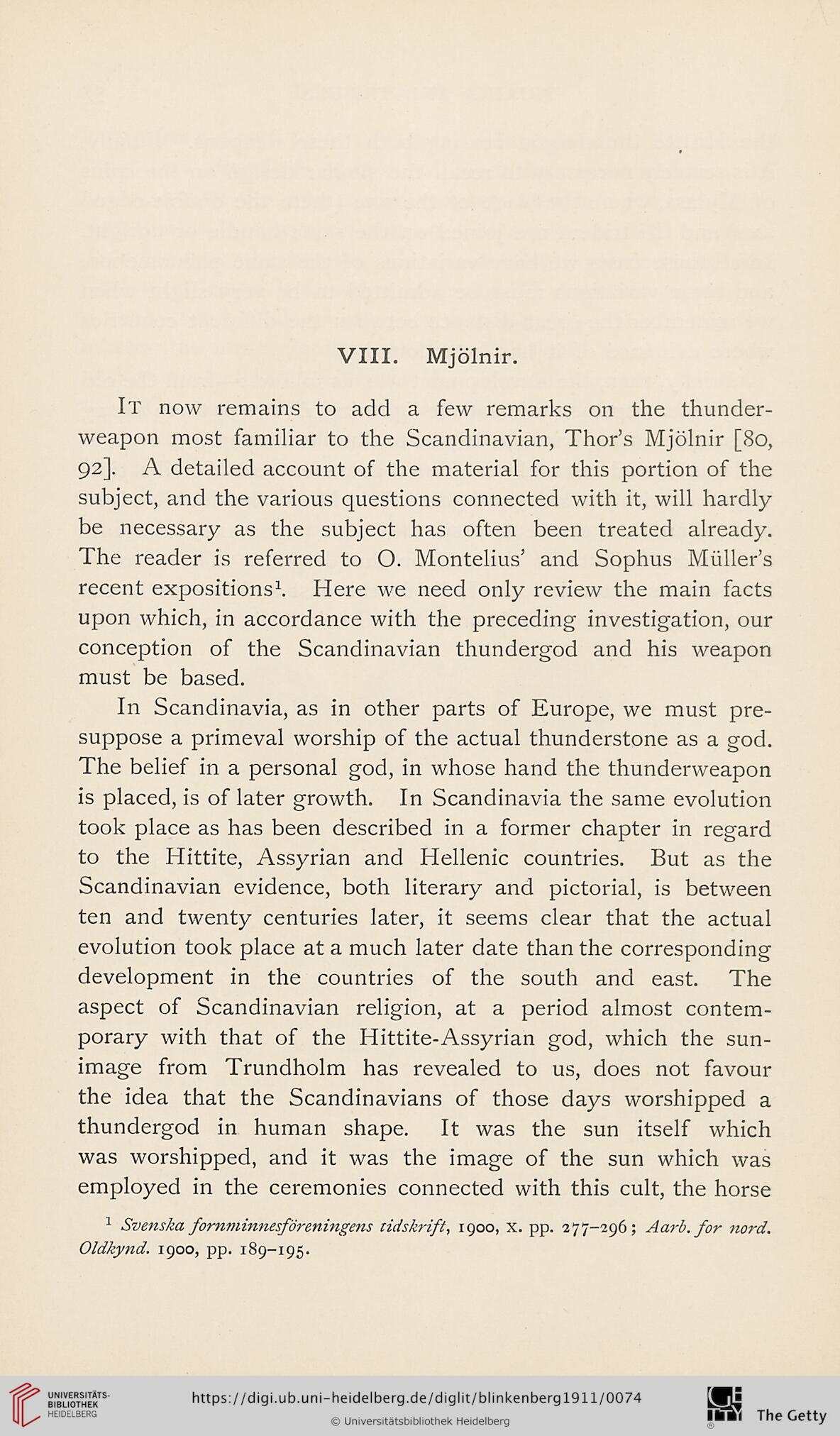VIII. Mjolnir.
It now remains to add a few remarks on the thunder-
weapon most familiar to the Scandinavian, Thor’s Mjolnir [80,
92]. A detailed account of the material for this portion of the
subject, and the various questions connected with it, will hardly
be necessary as the subject has often been treated already.
The reader is referred to O. Montelius’ and Sophus Muller’s
recent expositions1. Here we need only review the main facts
upon which, in accordance with the preceding investigation, our
conception of the Scandinavian thundergod and his weapon
must be based.
In Scandinavia, as in other parts of Europe, we must pre-
suppose a primeval worship of the actual thunderstone as a god.
The belief in a personal god, in whose hand the thunderweapon
is placed, is of later growth. In Scandinavia the same evolution
took place as has been described in a former chapter in regard
to the Hittite, Assyrian and Hellenic countries. But as the
Scandinavian evidence, both literary and pictorial, is between
ten and twenty centuries later, it seems clear that the actual
evolution took place at a much later date than the corresponding
development in the countries of the south and east. The
aspect of Scandinavian religion, at a period almost contem-
porary with that of the Hittite-Assyrian god, which the sun-
image from Trundholm has revealed to us, does not favour
the idea that the Scandinavians of those days worshipped a
thundergod in human shape. It was the sun itself which
was worshipped, and it was the image of the sun which was
employed in the ceremonies connected with this cult, the horse
1 Svenska fomminnesforeningens lidskrift, 1900, x. pp. 277-296; Aarb.for nord.
Oldkynd. 1900, pp. 189-195.
It now remains to add a few remarks on the thunder-
weapon most familiar to the Scandinavian, Thor’s Mjolnir [80,
92]. A detailed account of the material for this portion of the
subject, and the various questions connected with it, will hardly
be necessary as the subject has often been treated already.
The reader is referred to O. Montelius’ and Sophus Muller’s
recent expositions1. Here we need only review the main facts
upon which, in accordance with the preceding investigation, our
conception of the Scandinavian thundergod and his weapon
must be based.
In Scandinavia, as in other parts of Europe, we must pre-
suppose a primeval worship of the actual thunderstone as a god.
The belief in a personal god, in whose hand the thunderweapon
is placed, is of later growth. In Scandinavia the same evolution
took place as has been described in a former chapter in regard
to the Hittite, Assyrian and Hellenic countries. But as the
Scandinavian evidence, both literary and pictorial, is between
ten and twenty centuries later, it seems clear that the actual
evolution took place at a much later date than the corresponding
development in the countries of the south and east. The
aspect of Scandinavian religion, at a period almost contem-
porary with that of the Hittite-Assyrian god, which the sun-
image from Trundholm has revealed to us, does not favour
the idea that the Scandinavians of those days worshipped a
thundergod in human shape. It was the sun itself which
was worshipped, and it was the image of the sun which was
employed in the ceremonies connected with this cult, the horse
1 Svenska fomminnesforeningens lidskrift, 1900, x. pp. 277-296; Aarb.for nord.
Oldkynd. 1900, pp. 189-195.




